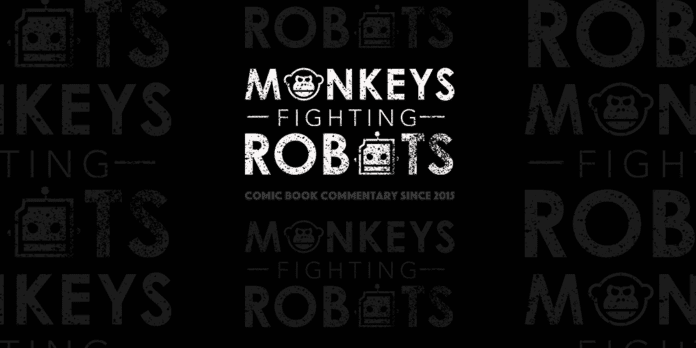The world today is much stranger than our forebearers could have ever foreseen. The dangers associated with late capitalism and consumerism culture have been a discussion point for decades, but seemed to fade into the background when convenience was dangled in front of us. Somewhere along the way, we decided to embrace that future rather than reject it. We took the “I’d buy that for a dollar” mentality that had been so thoroughly lampooned and turned it into a hashtag. We decided that greed was good after all. With Friendo, the team of Alex Paknadel (writer), Martin Simmonds (artist), Dee Cunnife (colorist), and Taylor Esposito (letterer) takes our obsession with social media and the material to its logical, frightening conclusion. The result is one of the most thought-provoking comics of the year.
Friendo is the story of Leo, a struggling actor just trying to make his way in a world where corporations have as much influence and power as states. When his girlfriend Rachel gifts him the latest craze in VR headwear, Leo is overjoyed, only to be immediately hit with a paywall. Fear not, however, the titular Friendo app comes with a freemium plan. Say hello to Jerry: the ghost in the machine, Leo’s personalised AI. He’s a search-engine, GPS, and personal shopper all-in-one. He’s also the worst possible influence. Leo may have gotten more than he bargained for.
The society of Friendo is one not too far removed from our own, consumed by the desire to have the latest thing, keep up-to-date, and be on trend. Technology is new frontier. Everything is driven by algorithms and our willingness to turn personal information into a commodity. In this way, the book is quite Lynchian in its sensibilities. There is an uneasiness to the whole affair, from the political landscape to the state of the environment, nothing is as it should be. This is a world that seems eerily resigned to itself. Paknadel isn’t afraid to ask his readers to engage with some important themes and ponder upon their own habits. It’s his willingness to let the reader be uncomfortable that really makes Friendo stand out.
A book has to be more than just its premise if it is to keep our interest. Friendo comes packaged with some rather intriguing characters. Leo himself is shallow, obsessed with his own self-worth. He lusts for luxury because it is something that has eluded him his whole life. Leo’s inability to judge himself in anything other than monetary terms manifests as a willingness to put himself in harm’s way. While his backstory makes this compulsion understandable, it makes him no less likable. Yet, in spite of it all, there is something morbidly fascinating about Leo that’ll bring you back for more. No wonder he finds himself drawn to Jerry. As a marketing AI, he is less the devil on your shoulder and more the devil in your smartphone. Jerry represents the insidious nature of consumerism and an almost palatable kind of sleaziness. It dresses well, it seduces you with its words, but only cares about you so long as you continue to play its game. The dichotomy between the two presents some interesting scope for exploration, particularly given the unexpected turns the story takes throughout the issue.
The artwork in Friendo is compelling in its viciousness. Simmonds, as he proved previously in Punks Not Dead, lends a weightiness to his characters that gives a viscerality to the events of the issue. His artwork excels at depicting the ugliness of a world that bathes itself in a gloss just so that it can look at itself in the mirror. Yet, equally, Simmonds succeeds in capturing the sterility of a life devoid of meaning other than the material. It’s a testament to his skill as an artist that the emotional content of the issue appears effortless.
Cunniffe’s colours are quite simply hypnotic. The use of rusted oranges in Friendo depicts night-time Los Angeles as a city that’s almost being corroded by its inhabitants. What’s most impressive, however, is that each scene is given a distinct flavour that skilfully brings us on a tour of LA. The tonal shifts and choice in colours speak to the inescapable fact that a single city can wear many faces at once. Fitting given the book’s attitude towards targeted advertising, serving up the version of reality most suited to the individual. Esposito’s lettering style is well-tailored to the choices of his collaborators eschewing thick balloon and caption borders for a more seamless merging of art and letters. Everything is just so and doesn’t stray into the extravagant. There is, however, one particular instance late in the issue where Esposito executes an incredibly clever obscuring effect which will leave you grinning.
With its cutting critique of technology and consumerism culture, Friendo invokes the spirit of the original Robocop to great effect. Where it truly succeeds, however, is in its cast and craft. The end of the issue opens the door to exploring these ideas in a bold fashion with a cliffhanger that will leave you desperate to get your hands on the next installment. This is science-fiction as it should be: a twisted, fractured version of reality that’s just a bit too close for comfort. It’s refreshing to read a comic that isn’t afraid to be about something. Vault Comics are sure to have another hit on their hands with Friendo.
Friendo #1 is available in all good comic shops on 19th September and is published by Vault Comics.
A review copy was kindly provided by the creative team.








